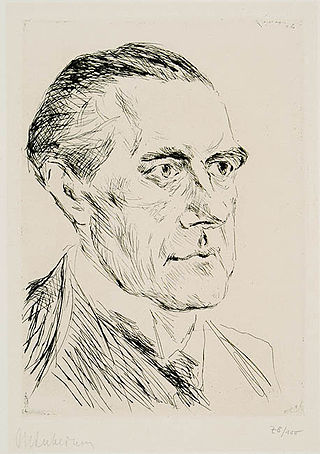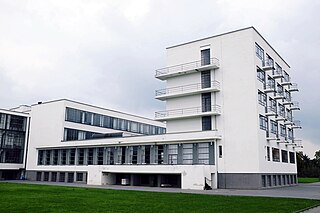
The Staatliches Bauhaus, commonly known as the Bauhaus, was a German art school operational from 1919 to 1933 that combined crafts and the fine arts. The school became famous for its approach to design, which attempted to unify individual artistic vision with the principles of mass production and emphasis on function. Along with the doctrine of functionalism, the Bauhaus initiated the conceptual understanding of architecture and design.

Walter Adolph Georg Gropius was a German-American architect and founder of the Bauhaus School, who, along with Alvar Aalto, Ludwig Mies van der Rohe, Le Corbusier and Frank Lloyd Wright, is widely regarded as one of the pioneering masters of modernist architecture. He was a founder of Bauhaus in Weimar (1919). Gropius was also a leading architect of the International Style.

The Deutscher Werkbund is a German association of artists, architects, designers and industrialists established in 1907. The Werkbund became an important element in the development of modern architecture and industrial design, particularly in the later creation of the Bauhaus school of design. Its initial purpose was to establish a partnership of product manufacturers with design professionals to improve the competitiveness of German companies in global markets. The Werkbund was less an artistic movement than a state-sponsored effort to integrate traditional crafts and industrial mass production techniques, to put Germany on a competitive footing with England and the United States. Its motto Vom Sofakissen zum Städtebau indicates its range of interest.

Interbau was a housing development, constructed as part of the 1957 International Building Exhibition in the Hansaviertel area of West Berlin. The overall plan was managed by Otto Bartning, and the urban design competition was won by Gerhard Jobst and Willy Kreuer, whose plans were later executed in a modified form.

Peter Behrens was a leading German architect, graphic and industrial designer, best known for his early pioneering AEG Turbine Hall in Berlin in 1909. He had a long career, designing objects, typefaces, and important buildings in a range of styles from the 1900s to the 1930s. He was a foundation member of the German Werkbund in 1907, when he also began designing for AEG, pioneered corporate design, graphic design, producing typefaces, objects, and buildings for the company. In the next few years, he became a successful architect, a leader of the rationalist / classical German Reform Movement of the 1910s. After WW1 he turned to Brick Expressionism, designing the remarkable Hoechst Administration Building outside Frankfurt, and from the mid-1920s increasingly to New Objectivity. He was also an educator, heading the architecture school at Academy of Fine Arts Vienna from 1922 to 1936. As a well known architect he produced design across Germany, in other European countries, Russia and England. Several of the leading names of European modernism worked for him when they were starting out in the 1910s, including Ludwig Mies van der Rohe, Le Corbusier and Walter Gropius.

Bruno Julius Florian Taut was a renowned German architect, urban planner and author of Prussian Lithuanian heritage. He was active during the Weimar period and is known for his theoretical works as well as his building designs.

The first Werkbund Exhibition of 1914 was held at Rheinpark in Cologne, Germany.
Heinrich Tessenow was a German architect, professor, and urban planner active in the Weimar era.
The November Group was a group of German expressionist artists and architects. Formed on 3 December 1918, they took their name from the month of the German Revolution.

Bernhard Hans Henry Scharoun was a German architect best known for designing the Berliner Philharmonie and the Schminke House in Löbau, Saxony. He was an important exponent of organic and expressionist architecture.
Hugo Häring was a German architect and architectural writer best known for his writings on "organic architecture", and as a figure in architectural debates about functionalism in the 1920s and 1930s, though he had an important role as an expressionist architect.

Expressionist architecture was an architectural movement in Europe during the first decades of the 20th century in parallel with the expressionist visual and performing arts that especially developed and dominated in Germany. Brick Expressionism is a special variant of this movement in western and northern Germany, as well as in the Netherlands.

The Weissenhof Estate is a housing estate built for the 1927 Deutscher Werkbund exhibition in Stuttgart, Germany. It was an international showcase of modern architecture's aspiration to provide cheap, simple, efficient, and good-quality housing.
The Arbeitsrat für Kunst was a union of architects, painters, sculptors and art writers, who were based in Berlin from 1918 to 1921. It developed as a response to the Workers and Soldiers councils and was dedicated to bringing current developments and tendencies in architecture and art to a broader population.

Max Taut was a German architect of Prussian Lithuanian heritage.

The New Objectivity is a name often given to the Modern architecture that emerged in Europe, primarily German-speaking Europe, in the 1920s and 30s. It is also frequently called Neues Bauen. The New Objectivity remodeled many German cities in this period.

The Siemensstadt Settlement is a nonprofit residential community in the Charlottenburg-Wilmersdorf district of Berlin. It is one of the six Modernist Housing Estates in Berlin recognized in July 2008 by UNESCO as a World Heritage Site because of their outstanding modernist architecture and contribution to the progressive housing reform movement during the Weimar Republic.
Erwin Anton Gutkind, was a German-Jewish architect and city planner, who left Berlin in 1935 for Paris, London and then Philadelphia, where he became a member of the faculty of the University of Pennsylvania. Of his work in Germany, all but one building remains and as of 2013 most if not all have historical protection orders on them. Some of them have also been restored.
Werkbund exhibition – The Dwelling was an exhibition organised by Deutscher Werkbund held in Stuttgart between July and October 1927.












